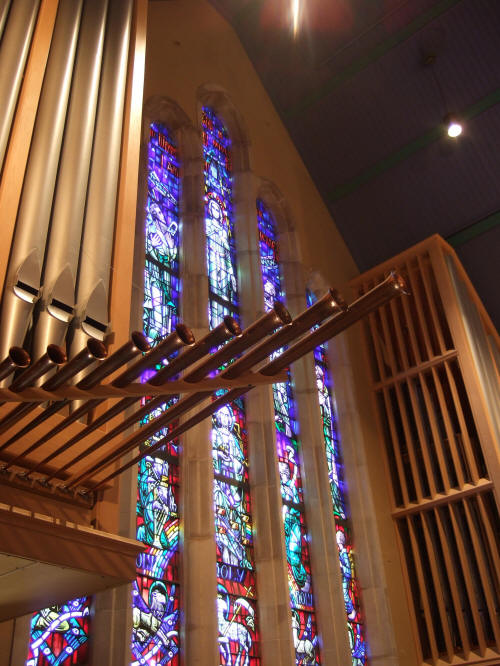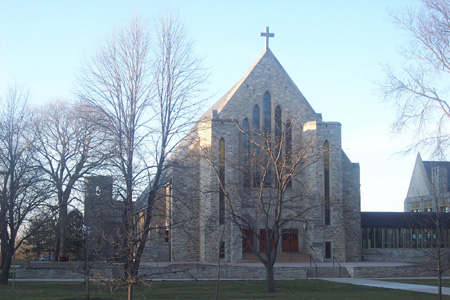|
Builder: Schlicker Organ Co, 1960 Manuals: 3 Ranks: 76 Action: Electropneumatic Notes: The organ was dedicated with two recitals by Flor Peeters October 9 and 10, 1960. The organ, one of Schlicker's largest, was designed by Herman Schlicker in cooperation with Paul Ensrud of St Olaf and Raymond C. Boese. The organ is located in the balcony of the chapel and is voiced on low wind pressure. The Trompeta Real projects horizontally from the front of the case. -- Information from "The Diapason", December 1, 1960 -- The Great and Swell are to the right of the window, with Pedal and Positiv to the left. Antiphonal was prepared. Console had standard Schlicker tripper combination action, which eventually failed and was replaced. Photos from Internet. Third photo shows David N. Johnson at the Schlicker console. -- Stoplist unification is to the best of my recollection, having studied the organ in detail for a graduation honors paper. Notes below on mixtures are from that research. David Engen GREAT ORGAN 16' Gemshorn 12 8' Principal 61 8' Gemshorn 61 8' Holzflöte 61 4' Octave 61 4' Spitzflöte 61 2.2/3' Quint 61 2' Octave 61 2' Mixture V-VII (4 pitches, 1-3 doubled) 1' Scharf IV 244 (1', 1/2', 2/3', 1/4' -- no quint in the bottom) 8' Trumpet 61 Chimes (prepared) 16' Trompeta Real tc 8' Trompeta Real 61 4' Trompeta Real 12 SWELL ORGAN 16' Quintadena 61 8' Principal 61 8' Rohrflöte 61 8' Salicional 61 8' Celeste 54 8' Dolce 61 4' Octave 61 4' Traversflöte 61 2.2/3' Nasat 61 2' Waldflöte 61 1.1/3' Mixture IV-VI (3 pitches only, 1-3 doubled) 16' Contra Fagott 61 8' Schalmei 61 4' Clarion 61 Tremolo POSITIV ORGAN 8' Holzgedeckt 61 8' Quintadena 61 4' Principal 61 4' Rohrflöte 61 2' Octave 61 2' Nachthorn 61 1.1/3' Larigot 61 1' Sifflöte 61 2.2/3' Sesquialtera II 122 1' Mixture IV-V 1/5' Zimbel III 183 (tierce on all notes) 16' Ranket 61 8' Krummhorn 61 4' Regal 61 Tremolo Zimbelstern 5 bells 16' Trompeta Real (Gt) 8' Trompeta Real (Gt) 4' Trompeta Real (Gt) PEDAL ORGAN 16' Principal 32 16' Gemshorn (Gt) 16' Subbass 32 16' Quintadena (Sw) 8' Octave 32 8' Gemshorn (Gt) 8' Gedeckt 32 4' Choralbass 32 4' Gedeckt 12 2' Hohlflöte 32 2' Rauschpfeife III 96 (spotted metal) 2.2/3' Mixture IV 128 (tin) 32' Contra-Fagott 12 16' Fagott 32 16' Ranket (Pos) 16' Trombone 32 8' Trumpet 32 4' Clarion 12 2' Cornet 12 ANTIPHONAL (prepared) 8' Rohrflöte 4' Spillflöte 2' Blockflöte Mixture II ANTIPHONAL PEDAL 16' Gedecktbass 4' Koppelflöte In my research I learned that as originally built the room had 7 seconds of reverberation. That is what Schlicker built the organ for, which is why there are so many doubled ranks in the mixtures. While the organ was being built, an acoustical consultant suggested padded pews, acoustic tile in the back stairwells, a curtain across the windows under the balcony, and rebuilding the balcony rail at an angle. Most of this was to eliminate flutter echo from the back wall. Only the curtains and the stairwell treatment were done, plus acoustic tile over the entire A-frame ceiling. This reduced reverberation to about 2 seconds when empty and nothing when full (I played the organ in several concerts when the room was packed, and the organ sounded like it was outside.) The story I was told was that when Herman arrived to the relatively dead room to install the organ he was furious at how it had been changed. He allowed only two weeks for tonal finishing. Nonetheless, the organ was used from early morning into late evening every day for decades and was extremely reliable. -- David Engen, class of '71 |
 |
 |
|
 |
|
Boe Chapel before the Schlicker was installed |
|
 |
|
|
|